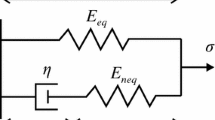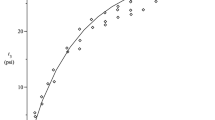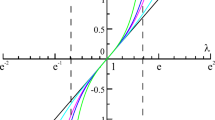Abstract
In incompressible isotropic elasticity, the Valanis and Landel strain energy function has certain attractive features from both the mathematical and physical view points. This separable form of strain energy has been widely and successfully used in predicting isotropic elastic deformations. We prove that the Valanis–Landel hypothesis is part of a general form of the isotropic strain energy function. The Valanis–Landel form is extended to take anisotropy into account and used to construct constitutive equations for anisotropic problems including stress-softening Mullins materials. The anisotropic separable forms are expressed in terms of spectral invariants that have clear physical meanings. The elegance and attractive features of the extended form are demonstrated, and its simplicity in analysing anisotropic and stress-softening materials is expressed. The extended anisotropic separable form is able to predict, and compares well with, numerous experimental data available in the literature for different types of materials, such as soft tissues, magneto-sensitive materials and (stress-softening) Mullins materials. The simplicity in handling some constitutive inequalities is demonstrated. The work here sets an alternative direction in formulating anisotropic solids in the sense that it does not explicitly use the standard classical invariants (or their variants) in the governing equations.
Similar content being viewed by others
References
Al-Kinani, R., Hartmann, S., Netz, T.: Transversal isotropy based on a multiplicative decomposition of the deformation gradient within p-version finite elements. Z. Angew. Math. Mech. (2014). doi:10.1002/zamm.201300155
Bellan C., Bossis G.: Field dependence of viscoelastic properties of MR elastomers. Int. J. Mod. Phys. B. 16, 2447–2453 (2002)
Bustamante R.: Transversely isotropic nonlinear magneto-active elastomers. Acta Mech. 210, 183–214 (2010)
Bustamante R., Shariff M.H.B.M.: A principal axis formulation for nonlinear magnetoelastic deformations: isotropic bodies. Eur. J. Mech. A Solids 50, 17–27 (2015)
Chui C., Kobayashi E., Chen X., Hisada T., Sakuma I.: Transversely isotropic properties of porcine liver tissue: experiments and constitutive modeling. Med. Bio. Eng. Comput. 45, 99–106 (2007)
Ciarletta P., Izzo I., Micera S., Tendick F.: Stiffening by fiber reinforcement in soft materials: a hyperelastic theory at large strains and its application. J. Mech. Behav. Biomed. Mater. 4, 1359–1368 (2011)
Dargazany R., Itskov M.: A network evolution model for the anisotropic mullins effect in carbon black filled rubbers. Int. J. Solids Struct. 46, 2967–2977 (2009)
Diani J., Brieu M., Gilormini P.: Observation and modeling of the anisotropic visco-hyperelastic behavior of a rubberlike material. Int. J. Solids Struct. 43(10), 3044–3056 (2006)
Diani J., Brieu M., Vacherand M.: A damage directional constitutive model for Mullins effect with permanent set and induced anisotropy. Eur. J. Mech. A Solids 25, 483–496 (2006)
Dokos S., Smaill B.H., Young A.A., LeGrice I.J.: Shear properties of passive ventricular myocardium. Am. J. Physiol. Heart Circ. Physiol. 283, H2650–H2659 (2002)
Dorfmann A., Pancheri F.: A constitutive model for the Mullins effect with changes in material symmetry. Int. J. Nonlinear Mech. 47(8), 874–887 (2012)
Feng Y., Okamoto R.J., Namani R., Genin G.M., Bayly P.V.: Measurements of mechanical anisotropy in brain tissue and implications for transversely isotropic material models of white matter. J. Mech. Behav. Biomed. Mater. 23, 117–132 (2013)
Hanson D.E., Hawley M., Houlton R., Chitanvis K., Rae P., Orler B.E., Wrobleski D.A.: Stress softening experiments in silica-filled polydimethylsiloxane provide insight into a mechanism for the Mullins effect. Polymer 46(24), 10989–10995 (2005)
Humphrey J., Yin F.: Biomechanical experiments on excised myocardium: Theoretical considerations. J. Biomech. 22(4), 377–383 (1989)
Humphrey J., Strumpf R., Yin F.: Determination of a constitutive relation for passive myocardium: I. A new functional form. J. Biomech. Eng. 112(3), 340–346 (1990)
Hill R.: Constitutive inequalities for isotropic elastic solids under finite strain. Proc. R. soc. Lond. A 314, 457–472 (1970)
Holzapfel G.A., Ogden R.W.: Constitutive modeling of passive myocardium: a structurally based framework of material characterization. Philos. Trans. R. Soc. A 367, 3445–3475 (2009)
Itskov, M., Aksel, N.A.: Class of orthotropic and transversely isotropic hyperelastic constitutive models based on polyconvex strain energy function. Int J Solids Stuct 41, 3833–3848 (2004)
Itskov, M., Halberstroh, E., Ehret, A.E., Vhringer, M.C.: Experimental observation of the deformation induced anisotropy of the Mullins effect in rubber. Kaut. Gummi. Kunstst. 93–96 (2006)
Jones D.F., Treloar L.R.G.: The properties of rubber in pure homogeneous strain. J. Phys. D Appl. Phys. 8(11), 1285–1304 (1975)
Kankanala S.V., Triantafyllidis N.: On finitely strained magnetorheological elastomers. J. Mech. Phys. Solids 52, 2869–2908 (2004)
Machado G., Chagnon G., Favier D.: Induced anisotropy by the Mullins effect in filled silicone rubber. Mech. Mater. 50, 70–80 (2012)
Marckmann G., Verron E.: Comparison of hyperelastic models for rubber-like materials. Rubber Chem. Technol. 79, 835–858 (2006)
May-Newman K., Yin F.: A constitutive law for mitral valve tissue. J. Biomech. Eng. 120(1), 38–47 (1998)
Mullins L., Tobin N.R.: Theoretical model for the elastic behaviour of filler reinforced vulcanized rubbers. Rubber Chem. Technol. 30, 551–571 (1957)
Ogden R.W.: Large deformation isotropic elasticity: on the correlation of theory and experiment for incompressible rubberlike solids. Proc. R. Soc. Lond. A 326, 565–584 (1972)
Ogden R.W.: Non-linear Elastic Deformations. Dover, New York (1997)
Ogden, R.W.: Nonlinear elasticity, anisotropy and residual stresses in soft tissue. In: Holzapfel G.A., Ogden R.W. (eds) Biomechanics of soft tissue in cardiovascular systems. CISM courses and lectures vol 441, pp. 65–10. Springer (2003)
Saccomandi, G.: Phenomenological theory of rubber-like elasticity. In: Saccomandi, G., Ogden, R.W. (2004) Thermomechanics of Rubber-Like Elasticity: CISM Lectures Notes 452, pp. 91–134. Springer Wien, NewYork (2004)
Shariff M.H.B.M.: Strain energy function for filled and unfilled rubberlike material. Rubber Chem. Technol. 73, 1–21 (2000)
Shariff M.H.B.M.: An anisotropic model of the Mullins effect. J. Eng. Math. 56, 415–435 (2006)
Shariff M.H.B.M.: Nonlinear transversely isotropic elastic solids: an alternative representation. Q. J. Mech. Appl. Math. 61, 129–149 (2008)
Shariff M.H.B.M.: Anisotropic stress-softening model for compressible solids. Z. Angew. Math. Phys. (ZAMP) 60, 1112–1134 (2009)
Shariff M.H.B.M.: Physical invariants for nonlinear orthotropic solids. Int. J. Solids Struct. 48, 1906–1914 (2011)
Shariff M.H.B.M.: Nonlinear orthotropic elasticity: only six invariants are independent. J. Elast. 110, 237–241 (2013a)
Shariff M.H.B.M.: Physical invariant strain energy function for passive myocardium. Biomech. Model Mechanobiol. 12, 215–223 (2013b)
Shariff M.H.B.M.: Direction dependent orthotropic model for Mullins materials. Int. J. Solids Struct. 51, 4357–4372 (2014)
Shariff M.H.B.M., Bustamante R.: On the independence of strain invariants of two preferred direction nonlinear elasticity. Int. J. Eng. Sci. 97, 18–25 (2015)
Shariff, M.H.B.M., Bustamante, R., Hossain, M., Steinmann, P.: A novel spectral formulation for transversely isotropic magneto-elasticity Math. Mech. Solids (2015). doi:10.1177/1081286515618999
Valanis K.C., Landel R.F.: The strain-energy function of hyperelastic material in terms of the extension ratios. J. Appl. Phys. 38, 2997–3002 (1967)
Weinberg E.J., Kaazeempur-Mofrad M.R.: A large-strain finite element formulation for biological tissues with application to mitral valve leaflet tissue mechanics. J. Biomech. 39, 1557–1561 (2006)
Weiss, J.A., Gardiner, J.C., Bonifasi-Lista, C.: Ligament material behavior is nonlinear, viscoelastic and rate-independent under shear loading. J. Biomech. 35, 943–950 (2002)
Yin F.C.P., Strumpf R.K, Chew P.H., Zeger S.L.: Quantification of the mechanical properties of noncontracting canine myocardium under simultaneous biaxial loading. J. Biomech. 20, 577–589 (1987)
Author information
Authors and Affiliations
Corresponding author
Rights and permissions
About this article
Cite this article
Shariff, M.H.B.M. Anisotropic separable free energy functions for elastic and non-elastic solids. Acta Mech 227, 3213–3237 (2016). https://doi.org/10.1007/s00707-015-1534-9
Received:
Revised:
Published:
Issue Date:
DOI: https://doi.org/10.1007/s00707-015-1534-9




